I. What are the Processes of Cell Determination, Differentiation, and Migration?
Though highly complex and sometimes a little too much for our brains to handle after one sitting, the intricacies of embryogenesis is definitely one to be admired! There are so many little details that occur both on a cellular and subcellular level which makes this all possible!
We’ll cover 3 of these processes in this article and will do our best to not only make our explanation as simple as possible, but to also just give you the necessary amount of information that the MCAT will likely test you on — you guys already have enough to study!
II. Processes of Cell Determination, Differentiation, and Migration
All the above mentioned processes are particularly unique to the various stem cells that arise from the embryo. As such, it’s through these processes that our bodies can generate the various amounts of specialized cells that’s required by our body!
A. Cell Determination v.s. Differentiation
Probably the trickier part of this article is understanding the difference between cell determination and differentiation — let’s go ahead and try to break them down! The best word to associate with cell determination is “irreversible commitment”.
When a cell becomes determined, it means it’s now committed to a pathway to become a unique, specialized cell; however, the cell looks phenotypically similar to other stem cells. As such, no outside influences from neighboring cells are molecules that can result in a change in pathway commitment.
In cell determination, only a certain number of genes that are specific to committing that stem cell to a pathway for cell specialization remain active as euchromatin!
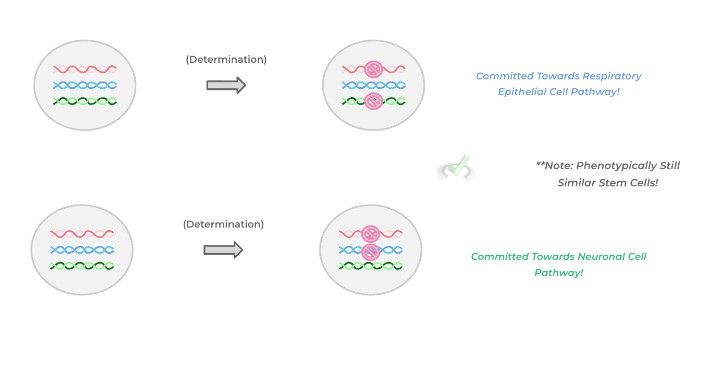
The best word/phrase to associate with cell differentiation is “morphological difference” as now the stem cell is actively changing its morphology in order to differentiate into the specialized cell that was determined in cell determination!
Here, differential gene expression allows for the stem cell to express certain genes and their products which are specific towards a particular cell type!
This, accompanied with changes in cellular biochemistry, metabolism, etc., allows for a cell to differentiate morphologically and physiologically allows the cell to differentiate and become the specialized cell it was committed to!
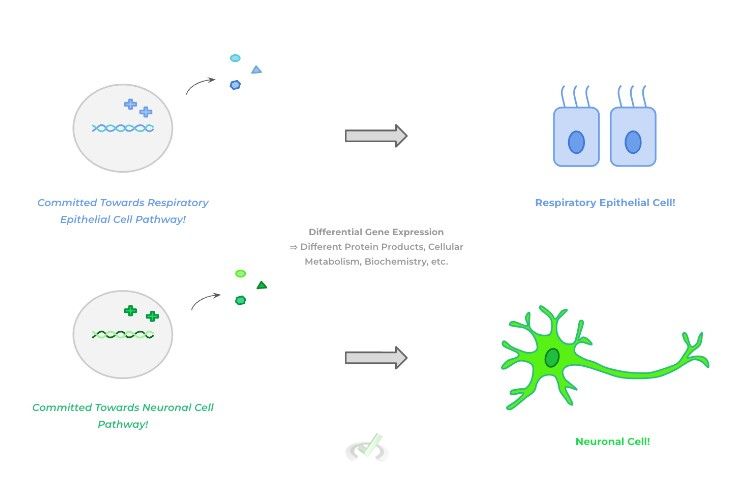
To give a better application of cell determination, let’s apply the definition to the different types of stem cells! There are 3 main types of stem cells: totipotent, pluripotent, and multipotent — recall that they differ in the “potency” or ability to eventually differentiate into specific cell types!
Totipotent cells can differentiate into any cell type (embryonic or extra-embryonic), pluripotent cells can differentiate into any embryonic cell type (NOT extraembryonic), and multipotent cells can only differentiate to a more limited subset of cell types (think about the stem cells in the gastrulation layers!)
When applying the definition of cell determination to the different types of stem cells, we can say that totipotent stem cells are LEAST determined because they still have the potency to differentiate into any cell type!
Conversely, multipotent stem cells are the MOST determined out of the stem cells because they’re more limited in regards to the cells they can eventually differentiate into!
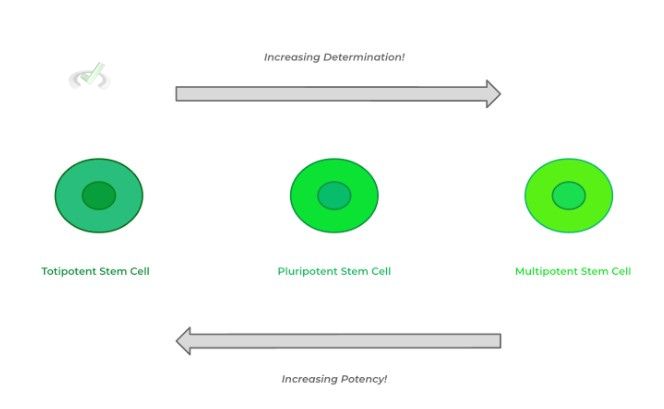
B. Cell Migration
Another crucial process during embryonic development is the proper migration of specialized cells to their appropriate locations throughout the body!
This even occurs early on in embryogenesis where the cells of the inner cell mass migrate in order to generate the 3 germ layers in gastrulation: the ectoderm, mesoderm, and endoderm.
Without getting into too many specifics, embryonic cell migration works in a very similar fashion to the chemotaxis of leukocytes: a chemoattractant is released and binds to receptors located on the cell. This results in a polarization of the cell which promotes movement in the direction of the chemoattractant.
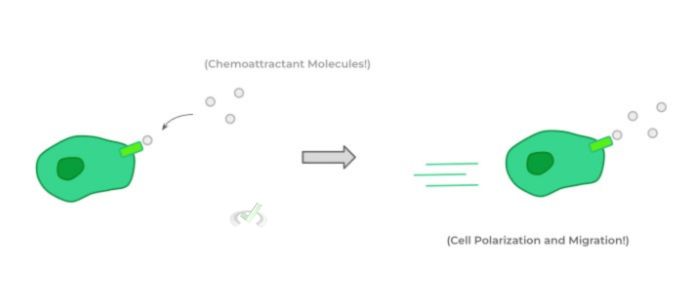
III. Bridge/Overlap
Though all our cells essentially have identical DNA to one another, it’s through the process of differential gene expression that certain genes can be active and inactive in order to allow for the differentiation of a stem cell to a specialized cell type.
This differential gene expression can occur due to the various processes involved in epigenetics! Let’s go ahead and review some of the major components of epigenetics and how it can lead to differential gene expression!
I. Euchromatin v.s. Heterochromatin
In its simplest form, epigenetics refers to how accessible a certain gene segment is in order for transcription factors and enzymes to be recognized and eventually expressed. There are 2 main states that the DNA can be in when referring to epigenetics: euchromatin and heterochromatin.
Euchromatin is the “open” conformation of DNA as it’s highly dissociated from the histone proteins allowing it to be accessible to all the necessary proteins for transcription and gene expression.
Contrarily, heterochromatin is the “closed” conformation of DNA as its very closely associated with the histone proteins, making it difficult for the transcription proteins to access the DNA.
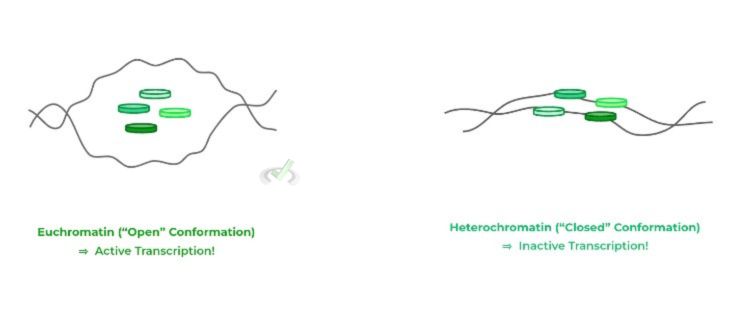
IV. Wrap Up/Key Terms
Let’s take this time to wrap up & concisely summarize what we covered above in the article!
A. Cell Determination v.s. Differentiation
The best word/phrase to associate with cell determination is “irreversible commitment” as the stem cell is committed towards becoming a certain specialized cell! It enters into a pathway where only certain genes specific towards a specific cell type remain viable for transcription!
In contrast, the best word/phrase to associate with cell differentiation is “morphological difference” as the stem cell now actively changes its cell morphology,
biochemistry, protein products, etc. in order to differentiate into the specialized cell determined in cellular determination!
B. Cell Migration
The migration of cells to their appropriate locations in embryogenesis follows similar mechanisms to the cellular migration of leukocytes!
A chemoattractant binds to receptors on the cell surface which causes the cell to polarize and migrate in the direction of the chemoattractant!
V. Practice
Take a look at these practice questions to see and solidify your understanding!
Sample Practice Question 1
Hematopoietic stem cells are types of stem cells that only give rise to the various types of blood cells such as leukocytes, red blood cells, etc. Which of the following best describes these types of cells?
A. Multipotent, Low Determination
B. Multipotent, High Determination
C. Totipotent, Low Determination
D. Pluripotent, High Determination
Ans. B
Because hematopoietic stem cells can only differentiate into the various blood cells, it is most likely a multipotent stem cell due to its limited potency.
In addition, because it’s the most limited in regards to potency out of the stem cells, it most likely has the high cellular determination as it now only has a limited number of cells to commit to in regards to differentiation.
Sample Practice Question 2
An embryologist analyzes the epigenetic pattern of a stem cell. She notices that after epigenetic analysis, there are specific gene segments which have an open, euchromatin conformation while still sharing a similar morphology to other stem cells. Which of the following processes as the cell completed?
A. Cellular Determination
B. Cellular Differentiation
C. Cellular Migration
Ans. A
Recall that cellular determination refers to when a cell commits towards a particular pathway to become a specialized cell! Here, only certain genes that are specific to that cell type remain active while still being phenotypically similar to the other cells!
It’s during differentiation where the cell will change its morphology in order to become that specialized cell — it will go on to change its biochemistry, protein products, etc.







 To help you achieve your goal MCAT score, we take turns hosting these
To help you achieve your goal MCAT score, we take turns hosting these 





















 reviews on TrustPilot
reviews on TrustPilot